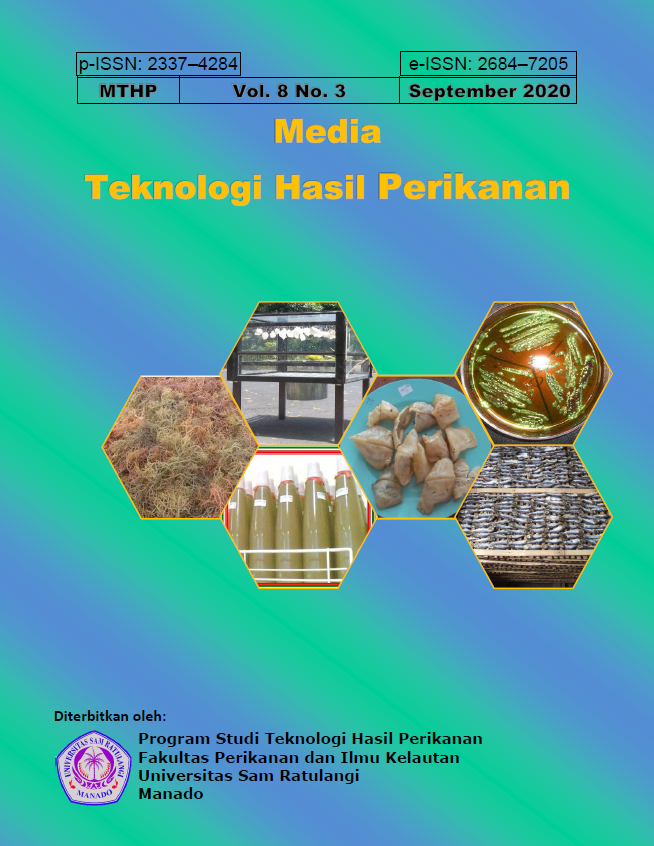Efek Perendaman Terhadap Kandungan Serat Kasar, pH dan Skor Sensori Rumput Laut Kappaphycus alvarezii
DOI:
https://doi.org/10.35800/mthp.8.3.2020.29578Keywords:
Kappaphycus alvarezii, seaweed, immersion, sensory, pH, crude fiberAbstract
One type of seaweed that is widely used in Indonesia is Kappaphycus alvarezii . This type of seawed is also known as Eucheuma cottonii. The purpose of this study was to compare the value of crude fiber content, pH, and sensory score of Kappaphycus alvarezii after being soaked with 2 different types of water (well water and demineralized water). Soaking process is intended for making seaweed -ice by using dried seaweed as raw material. The parameters tested in this study were crude fiber, pH and sensory using Hedonic scale 1-9. The results indicated that Kappaphycus alvarezii soaked with demineralized water had higher crude fiber content (1.37%) compared to seaweed soaked in well water (1.24%). Likewise, the pH level of seaweed products that are soaked with demineralized water have a higher pH value (6.27) than seaweed products that are soaked in well water (6.19). Furthermore, organoleptic test results show that seaweed products that are soaked with water demineralization was more preferable by panelist in terms of appearance, odor, texture and taste.
Salah satu jenis rumput laut yang banyak dimanfaatkan di Indonesia adalah rumput laut Kappaphycus alvarezii . Rumput laut ini juga dikenal dengan nama Eucheuma cottonii. Tujuan penelitian ini adalah membandingkan nilai kadar serat kasar, pH, dan skor sensori rumput laut Kappaphycus alvarezii setelah direndam dengan 2 jenis air berbeda (air sumur dan air demineralisasi). Proses perendaman ditujukan untuk pembuatan es rumput laut dengan menggunakan rumput laut kering. Parameter yang diuji pada penelitian ini adalah serat kasar, pH dan uji sensori menggunakan uji Hedonik skala 1 – 9. Hasil analisa menunjukkan bahwa rumput laut Kappaphycus alvarezii yang direndam dengan air demineralisasi memiliki kandungan serat kasar yang lebih tinggi (1.37%) dibandingkan dengan rumput laut yang direndam dengan air sumur (1.24%). Pada pengujian kadar pH, produk rumput laut yang direndam dengan air demineralisasi memiliki nilai pH yang lebih tinggi (6.27) dari pada produk rumput laut yang direndam dengan air sumur (6.19), Selanjutnya, hasil uji organoleptik menunjukkan bahwa produk rumput laut yang direndam dengan air demineralisasi lebih disukai panelis dari segi kenampakan, bau, tekstur dan rasa.
References
Apriyantono A, F. D. 1989. Petunjuk Laboratorium Analisis Pangan.
Association of official Analytical and Chemistry (AOAC). 2005. Penentuan kadar derajat keasaman (pH). Official Methods of Analysis.
Daud, R. 2013. Pengaruh Masa Tanam terhadap Kualitas Rumput Laut Kappaphycus alvarezii. Balai Penelitian dan Pengembangan Budidaya Air Payau, Media Akuakultur, Volume 8 Nomor 2.
Kadi, A. 2004. Potensi Rumput Laut Dibeberapa Perairan Pantai Indonesia. Oseana. Volume XXIX, Nomor 4, Tahun 2004, 25–36.
Kumesan E Ch, d. 2017. Analisa Total Bakteri Kadar Air dan pH pada Rumput Laut Kappaphycus alvarezii dengan Dua Metode Pengeringan. Jurnal Media Teknologi Hasil Perikanan,, Vol 5 No 1.
Lalopua, V. 2018. Karakteristik Fisik Kimia Rumput Laut Merah Hypnea Saidana Menggunakan Metode Pembuatan Berbeda Dengan Penjemuran Matahari. Jurnal Majalah Biam, 28–36.
Muhtar, N. 2019. Analisa Sensori Antioksidan dan Kandungan Serat minuman Fungsional Rumput Laut Eucheuma Spinosum dengan Penambahan Rumput Laut Sargassum sp. J. Fish protech 2019, Vol. 2. No. 2.
Pratiwi, M. A. 2008. Pemanfaatan Tepung Hotong (Setaria italica (L) Beauv.) dan pasti sagu dalam pembuatan cookies. Departemen Ilmu dan Teknologi Pangan. Fakultas Teknologi Pertanian Bogor, Institut Pertanian Bogor.
Downloads
Published
How to Cite
Issue
Section
License
Authors who publish with this journal agree to the following terms:
- Authors retain copyright and grant the journal right of first publication with the work simultaneously licensed under a Creative Commons Attribution License that allows others to share the work with an acknowledgement of the work's authorship and initial publication in this journal.
- Authors are able to enter into separate, additional contractual arrangements for the non-exclusive distribution of the journal's published version of the work (e.g., post it to an institutional repository or publish it in a book), with an acknowledgement of its initial publication in this journal.
- Authors are permitted and encouraged to post their work online (e.g., in institutional repositories or on their website) prior to and during the submission process, as it can lead to productive exchanges, as well as earlier and greater citation of published work (See The Effect of Open Access).






